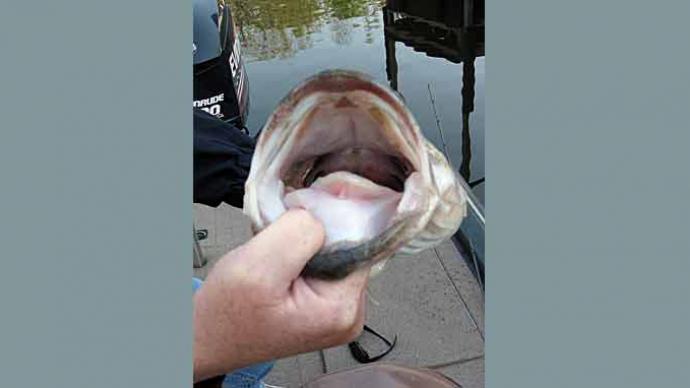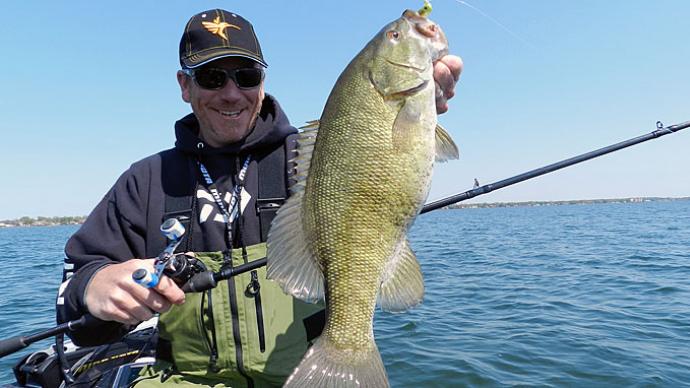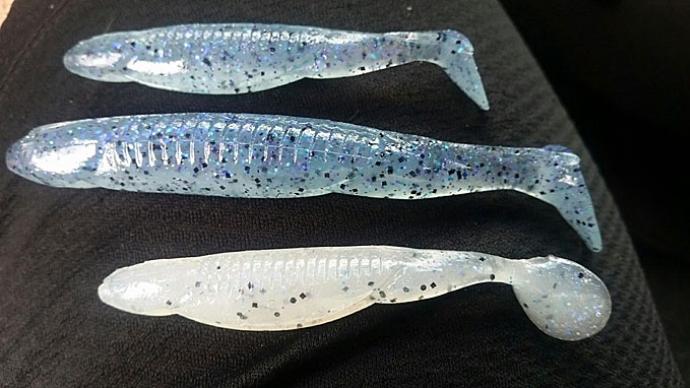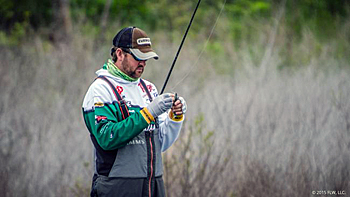
Matt Arey is well acquainted with the bass-catching power that swimbaits possess. A 5-inch swimbait played an essential role in the 55 pounds, 6 ounces of bass he caught over four days at Arkansas’ Beaver Lake in 2015. It was enough to win the FLW Tour Walmart Open, his second in as many years.
While that tournament is held in spring, Arey throws swimbaits all year. He said this lure helped him at every stop of the 2016 FLW Tour, where he finished 13th in the Angler of the Year standings. “I caught key fish [on swimbaits] at three or four tournaments this year,” he said. “Swimbaits catch big fish. That’s just a fact.”
Swimbaits, in one form or another, have been around for decades. Take Mister Twister’s Sassy Shad, for example. It was one of the first soft-plastic swimbaits for freshwater fishing. While most bass anglers viewed it as a panfish, walleye, or striper lure, it did gain some popularity with those fishing for smallmouth. In the mid-1990s, news of western anglers slinging swimbaits — some more than a foot long — and catching plenty of giant bass went nationwide. The realistic-looking lures caught on fast as anglers adapted them to their home lake. Soon there were swimbait rods, reels, and hooks. Today swimbaits are found in the tackle boxes of nearly every bass angler, and these lures all catch bass.
Like most lures, swimbaits come in various colors, shapes, and lengths, from two to 14 inches. “I have all sizes, all shapes, and all colors,” Arey said. The most popular are soft plastic and feature a flat kicker tail, such as the Strike King Shadalicious and Megabass Magdraft. The hard plastic is used to make others, such as glide baits. They slowly sink and move side to side when twitched. They are gaining popularity with anglers who target the biggest bass in a lake. Arey fishes glide baits — sometimes. He sees them as a niche lure that bass follow more often than bite. Swimbaits also use both materials, usually a hard bait with a soft-plastic tail. They all catch bass when used under the right conditions.
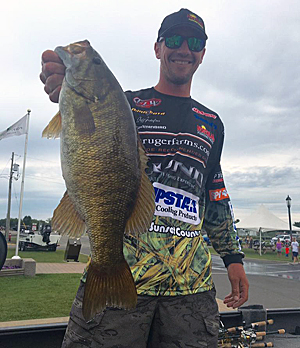
Arey is all about soft-plastic swimbaits. Bass follow them like they do hard swimbaits, but he said they strike them more often. That’s a significant difference when competing in tournaments. He might have a swimbait that might catch two 8-pounders each day, but that usually is not enough to win. So he’ll search for one that generates five or more bites from 3- and 4-pounders. That strategy will win nearly every time.
Swimbait fishing isn’t all big fish and tournament trophies. Arey winces when he thinks about its other side. “It can be the most frustrating style of fishing, especially when you have a 30-pound limit following a swimbait and you can’t catch them,” he said. “I’ve seen a swimbait, the day before a front rolled in, crush them. I’d have 30 bass follow it, and 28 would eat it. With high pressure and a bluebird sky the next day, I’d still have 30 bass follow it, but only two would commit to eating it.” You can’t give up when that happens, he said. Those bass will bite. But it will take persistence, which he believes is essential to catching bass on swimbaits.
Bass that follow a swimbait aren’t all bad, especially on tournament practice days, when hooking them — beyond a few to judge size — almost always means fewer to catch when it counts. You’ll know where they are, and you can return and catch them on a different lure that triggers more strikes. Arey followed that advice during the 2015 Walmart Open. He waited for each bass that chased his swimbait to return to the cover it left, and then he would cast a wacky-rigged 5-inch Lunkerhunt Lunker Stick at it. Few resisted the second offering.
Bass are fickle about swimbaits. Sure, they always seem willing to chase one, but it takes work each day to find the one they will eat. First, you need to look inside yourself. “Keep an open mind,” Arey said. You must be willing to change your presentation until you find one that gets hit. “A lot of times, it’s based on the retrieve,” he said. It’s the first thing the Shelby, N.C. angler adjusts when his swimbait isn’t generating bites. You can retrieve them at any speed, from slow rolling to burning just under the surface. And it’s easier to change that than diving into your tackle box for a different one or at the least a bottle of dye to change its color. But that’s what you’ll have to do if a different retrieve doesn’t work. And don’t get hung on one style or color of swimbait. “Don’t buy one pack,” he said. “You need a big arsenal.”
During tournament practice, Arey will rig six or seven rods with swimbaits, each a different size, color, and style. He’ll rotate through them during the day. Some have a shaking action, and others might kick. Some days a more subtle swimbait is the key to generating strikes.
Arey said swimbaits produce bass all year, but spring is his favorite season to fish them. That’s when bass are shallow, and you can see them, making it easier to watch how they react to your swimbait. He rigs them Texas-style on a wide-gap hook and no weight. He’ll swim them through and around shallow cover, hoping to trigger bass in all three stages of the spawn.
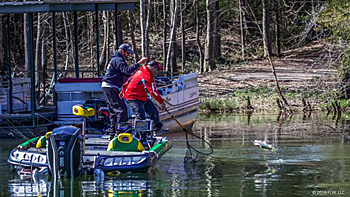
As spring turns to summer and water temperatures rise, Arey follows bass to offshore structure such as ledges, points, and humps. He rigs swimbaits on jig heads as heavy as 1.25 ounces to reach deep-water spots. Straight swimming and lift-and-drop retrieves through schools will produce strikes. On a rare occasion, he caught deep bass on a Lunkerhunt Bento Minnow swimbait rigged on a drop shot.
Jeff Gustafson has fished the FLW Tour for the past five years and qualified for his first Forest Wood Cup in 2016. He lives in Keewatin, Ontario, Canada, on the shores of Lake of the Woods. The almost 1,700-square-mile natural lake sits on the border of Ontario, Manitoba, and Minnesota, and its rocky waters are full of smallmouth. That gives him an ample opportunity to learn how to catch them.
Plenty of smallmouths are caught on swimbaits that are burned across shallow sandy flats littered with rock and aquatic vegetation. But that usually is not where Gustafson fishes when he’s casting one. He’ll be over much deeper water, especially where he finds gobies, the bottom-dwelling invasive species that’s fattened up plenty of Great Lakes region smallmouths.
Gustafson threads small swimbaits — such as the ones 2.8 to 3.8 inches long Keitech and Jackall make — on football or minnow-shaped jig heads. He rigs them like a grub, hook up through the back, tail down and straight as an arrow. “We like to use the football heads,” he said. “They seem to keep the tail off the bottom.” That’s important because that’s the stance gobies take. He fishes them in the same spots that other anglers drag tubes or shake drop shots. He throws them early summer through fall when most smallmouth relate to deep cover and structure.
Gustafson always leans toward heavier jig heads for this technique. He said they sink faster than light ones, so he isn’t wasting time waiting for his to reach the bottom. He’ll throw the rig on a casting rod if it weighs 3/8 ounce or more, and he’ll use a spinning rod for lighter ones.
Smallmouth aren’t the only ones that use deep water during late summer and early fall. Reservoir largemouth follow baitfish there, but they often suspend, maybe 20 feet down over 35 or 40 feet of water. You can find them on your electronics, but Arey said you couldn’t see them with your eyes, so you don’t know how they react to your swimbait. “You have to catch them to know you are doing the right thing,” he said. Here again, you’ll need to change your retrieve and swimbait until you start catching bass. He said they are feeding on shad and herring that hatched just a few months earlier, so a good first move is to downsize your swimbait.
Umbrella rigs are probably where most weekend and local tournament anglers use swimbaits. Arey no longer messes with them; FLW Tour banned them from competition starting in the 2014 season. But that doesn’t mean you have to stop, too. Their productivity may have dropped, but they are still tough to beat when schooling bass chase baitfish in the fall and winter. Whether you are running three, five, or more swimbaits on your rig, here are a few things to remember when picking out swimbaits.
Umbrella rigs disturb a lot of water. That can make it harder for each swimbait to find enough undisturbed water to make its tail kick. The best swimbaits are made from super soft plastic or have a body that slims down before attaching to the tail, which should be perpendicular to the body. The ones that fall back at an angle need more speed to kick. Avoid them.
When rigging up, select one swimbait that is different than the rest. It could be slightly larger or a different color. Many anglers believe that gives the bass a better target, feeding off their predatory instinct to attack prey that looks or acts differently. When you catch a bass, note which swimbait hooked it, adding a similar one to encourage more strikes.
BassResource may receive a portion of revenues if you make a purchase using a link above.


